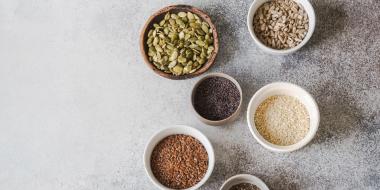Planning for pregnancy can be an exciting yet overwhelming time full of conflicting information and advice that can leave you feeling totally confused. What should you do? What should you stop doing? And how do you know if you can even make a baby?! Adopting a few basic habits, taking time to track your period, and making sure to let out a few deep relaxing exhalations will put you in a better position to know just what to expect before you’re even expecting!
TOODLE-OO TOXINS!
One of the first things most women do when hoping to conceive is to quickly ditch any obvious bad habits. Avoiding smoking, drugs, and overindulging in alcohol are no-brainers, but many women don’t realize that their fertility can also be impacted by the products they use on their bodies or in their homes. Endocrine disrupting chemicals (EDCs) like BPA and phthalates—commonly found in plastics, personal care products, and cosmetics—can mimic or block hormones essential for conception. Studies show that BPA affects egg quality, implantation, embryo and placental development, and unfortunately, BPA substitutes like BPS are just as harmful. Further, high concentrations of phthalates are linked to endometriosis, and in those undergoing IVF it can lead to a reduced egg retrieval, lower pregnancy rates, and higher risk of pregnancy loss.
Do your homework, read labels (here's a helpful guide!), and always choose the cleanest, least adulterated products you can!
CHOWING DOWN FOR CONCEPTION
Implementing a healthy diet rich in whole, unprocessed foods is a great way to help bolster your fertility and prepare your body for the rigours of pregnancy.
High Calibre Carbs: Carbohydrates are necessary for energy production, but too many (especially processed ones) can put a strain on glycemic load which is associated with higher risk of ovulatory infertility. Aim for high quality, unprocessed carbohydrates that are lower on the glycemic index such as quinoa, lentils, chickpeas, fruit, brown rice, whole grain bread, and oat porridge.
Favoured Fats: Fat is crucial for producing hormones, helping your eggs mature, and assisting in blastocyst implantation. Avoid trans fats as they increase insulin resistance and may prevent ovulation and decrease your chances of getting pregnant, and opt for healthy fats like omega-3 fatty acids instead. Omega-3s can help with progesterone production in the second half of your menstrual cycle and reduce the risk of anovulation. Food sources include fatty fish like mackerel and salmon, flax, chia, and walnuts.
Potent Proteins: While studies vary based on the efficacy of animal and plant-based proteins, it is generally agreed that ovulation is positively affected by incorporating vegetable and fish proteins into the diet (a diet heavy in red meat may negatively affect ovulation and blastocyst formation). Aim for at least one gram of protein per kilogram of body weight (more if you’re active), daily. When choosing meat sources, opt for organic and free-range or wild-caught; for plant-based proteins, seitan, most beans, and nut butters are rich sources. Be wary of mercury content in fish and avoid tuna, shark, swordfish, marlin, orange roughy, and escolar. And contrary to concerns over soy, it turns out that soy protein may be beneficial for women seeking fertility treatment, but ensure it’s organic and non-GMO. Avoid altogether if you have a thyroid condition. (Find more fertility-boosting foods here.)
Supplemental Supports
It is highly recommended to take prenatal supplements as you prepare for pregnancy. Not only can they help prevent neural tube defects in the baby, they also help get your body ready to support the growth and development that will soon take place! Since not all vitamins are created equal, it’s important to keep a few things in mind as you head down the supplement aisle.
B Vitamins and folate are prenatal vitamin staples that are typically found in their inactive forms. While your body can convert them into active forms, it can be difficult, especially if your digestive system is compromised. Choosing a supplement with active B vitamins guarantees better absorption, making it more readily available for use by your body. Look for bioactive forms of B like riboflavin-5-phosphate (B2), pyridoxal-5-phosphate (B6), and methylcobalamin (B12). When shopping for folate, keep an eye out for its active form, l-methylfolate, and choose a prenatal vitamin that contains at least 400 mcg.
Iron is a key nutrient to help support baby’s development, and ironically is also one that most women are already deficient in. Anemia, fatigue, cold hands and feet, restless leg syndrome, and even hair loss are all common symptoms of iron deficiency. As blood volume increases in the second and third trimester of pregnancy, iron levels further decline, making supplementation even more critical. This is especially important for vegans and vegetarians as iron deficiencies are common and oftentimes even a diet rich in leafy greens and lentils may not bring levels up quickly enough.
Iron supplements can often be hard on the digestive system and cause constipation, stomach pain, nausea, and vomiting. Most prenatal vitamins contain ferrous sulphate which isn’t well absorbed and can be the culprit behind those digestive upsets. To combat this, opt for a prenatal that contains a glycinate form of iron instead. You can also naturally improve your iron absorption by increasing your intake of citrus fruits and other foods high in vitamin C.
Citrates are less commonly found in commercially available prenatal vitamins but have the advantage of being more easily absorbed than their oxide counterparts, making them better able to support the many chemical processes that are happening during the preconception and prenatal period. Look for the citrate forms of zinc, magnesium, and copper, as well as for calcium (typically found in its less bioavailable carbonate form).
Unnecessary additives aren’t just found in prepackaged foods. Colourants and potentially harmful preservatives like BHT, which is a weak endocrine disruptor (and found in a popular prenatal!), are often added to supplements. It’s also important to note that some brands contain proprietary herbal blends that may sound good but aren’t always beneficial, especially if you don’t know how much of a particular herb you’re getting.
As always, speak to your healthcare provider before embarking on any new supplement program.
INSPECTING YOUR FERTILITY FOUNDATIONS
To become pregnant, you must be ovulating regularly and have unobstructed fallopian tubes. The first step to figuring out if ovulation is taking place is to pay careful attention to the features of your menstrual cycle.
Sex on the Schedule
Many couples attempting to get pregnant find that it isn’t as easy as expected. In fact, statistics reveal that most don’t conceive on their first (or second!) try—with 84 percent of couples getting pregnant within the first year of trying and 92 percent within two years. Studies show that most pregnancies can usually be attributed to having sex within a six-day period leading up to ovulation, with the highest rates around two days prior to ovulation. To increase your chances, consider having regular, unprotected sex two to three times per week, as sperm can survive in the vaginal canal for up to seven days!
Am I ovulating regularly?
Ovulation is essential to fertility because this is when your body releases an egg to potentially be fertilized by sperm. You may already be relying on an app to track your period and determine when you’re fertile and ovulating, and while your app estimates a predicted ovulation day, it isn’t a foolproof system. Fortunately, you can usually count on your body to provide a few signs to help you determine if and when ovulation is happening.
Cervical Fluid is a necessary part of conception as it protects and nourishes sperm as they enter the otherwise acidic vagina, allowing them to move freely in search of an egg. An important indicator of increased estrogen levels and luteinizing hormones (LH), the texture and colour of your cervical fluid changes based on where you are in your cycle. Five to six days before ovulation, you may notice yellow, white, or cloudy fluid that has a sticky or tacky texture. Two to three days before ovulation, there may be an abundance of clear and slippery fluid, similar to egg whites, that can be stretched between your fingers.
Hormone Surges can be detected using ovulation predictor kits (OPKs). A surge in luteinizing hormones causes the ovary to release an egg, typically taking place somewhere between 24 to 36 hours before ovulation begins. Once the egg has been released, it has a 12- to 24-hour window to be fertilized by sperm. You may want to use an OPK around the same time as your cervical fluid becomes clear and stretchy. Note that the OPK may indicate a result of two positive days: this is because the test is capturing both sides of the LH surge.
Basal Body Temperature (BBT) helps to indicate when ovulation is taking place by measuring the slight rise in your body temperature caused by an increase in progesterone production. It’s most useful to track BBT throughout your cycle, as it tells you when you’re ovulating, when progesterone production is on the rise, and the length of the second half of your cycle. It’s best to take your temperature first thing in the morning after at least three hours of sleep.
Not ovulating? Or at least not on the regular? Communicating with your healthcare provider will enable them to help diagnose underlying conditions that may be responsible for difficulties with conception. Some common culprits like polycystic ovary syndrome (PCOS), diminished ovarian reserve, hypothalamic functional amenorrhea, premature ovarian insufficiency, and menopause may be directly affecting your regular cycle. Issues like a history of pelvic infections, abdominal surgery, sexually transmitted infections (like chlamydia or gonorrhea), or endometriosis may have caused fallopian tube obstructions.
A great deal of time and energy can go into pregnancy planning and it can be overwhelming and frustrating if you aren’t familiar with the basic components, not to mention the common challenges, that are associated with the journey to successful conception. Monitoring your menstrual cycle, paying attention to the timing of your sexual activity, supporting your overall health through nutrition and a clean lifestyle, and addressing underlying conditions that may interfere with fertility will set you up for your best chance at baby-making!
For advice on preconception exercise and stress management visit ecoparent.ca/preconception-health






